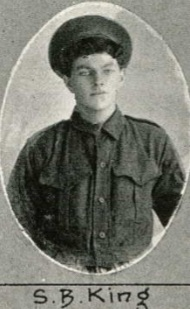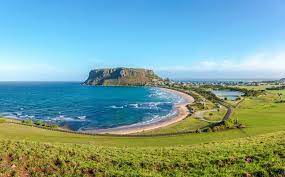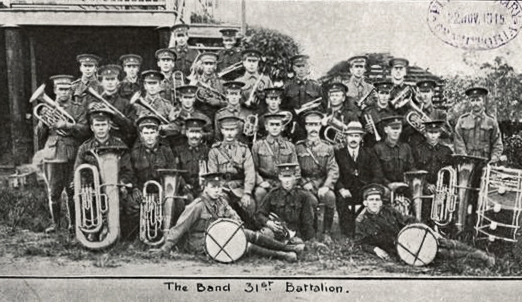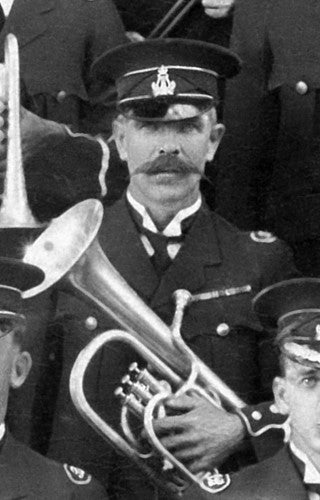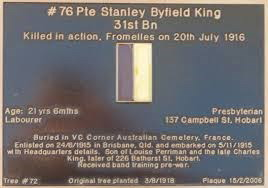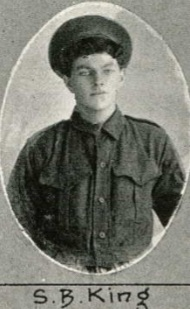
Stanley Byfield KING
Eyes blue, Hair black, Complexion fresh
Stanley Byfield KING: soldier, bandsman and stretcher bearer.
The search for DNA:
We would like to acknowledge the descendants of the Smith and King families from Tasmania, who were pleased to become DNA donors in the ongoing hope of an identification.
As of 2024, identification via DNA has been made for 180 of the soldiers reburied at the new Pheasant Wood Military Cemetery. 70 soldiers still await an identification.
If you know anything of his connections or relatives in Australia or elsewhere, we would love to hear from you.
Stanley’s Family
Stanley “Stan” Byfield King was born 9th April 1896 in Stanley Tasmania, and died 20th July 1916 in the Battle of Fromelles when he was just 20 years old.
Stan was born Stanley Byfield SMITH, to Lucy Smith (unmarried) and Charles King and certainly acknowledged by the KING family. Byfield is the name of a town in Northamptonshire where his great great grandmother and the Bromley/King family came from. The Kings and Smiths were pioneers of Northwestern Tasmania. Lucy’s twin sister Nina, married Alfred King. Charles King never married while Lucy married William George Perriman and eventually their blended family numbered eight. Lucy was the granddaughter of convicts William Taylor and Anne Perry, Joseph Smith and Mary Ann Kingham.
Known as “Tassie“ in the army, Stan was a member of the band of the 31st battalion, which was raised in Enoggera, Queensland in August, 1915. His name reflects both the name of the town in Tasmania where he was born and the family connection to the Byfield home of the King family who settled in the Stanley area in 1844. Stanley enlisted in the AIF on 24th June 1915 in Brisbane, Queensland, a long way from home in Stanley, Tasmania.
Stanley, Tasmania
The town of Stanley is a picturesque port town lying at the foot of an old extinct volcano which rises some 143 metres above sea level and has a distinctive flat top. In 1798 while circumnavigating the island of Tasmania, Flinders and Bass named the area Circular Head. In 1842, the town of Stanley officially came into being, named after the British Secretary for the Colonies, Lord Stanley (1799-1869). Today Stanley is both a popular tourist destination, boasting well preserved buildings from the 1800s and it is the main fishing port on the northwest coast of Tasmania.
According to the 1911 census, there were 613 adults and their children living in Stanley in 1911. And according to the newspapers and Gazettes from the time, pride of the town was the Stanley Brass Band. It included Stan and many extended family members.

Back row from left to right: J J Holmes, J G Smith, J Shepherd and J Trethewie.
Second row: K Chatwin, D Smith, J H Smith, P Madsen, Monte Edward Button and J E Burley.
Front row: P Carroll, W G Stuart, A C Smith, A W Penrose (conductor), D Ferguson, Percy J Button, H H Smith and V Ferguson.
Pride of the Town, The Stanley Brass Band.
Why Stan left Tasmania and went to Queensland is now hard to track down as there are few records of his early life. But he did have a family connection living in Queensland in 1914, his aunt’s brother, and fellow bandsman, Monte Edward Button, who also enlisted in the AIF.
Sapper Edward Button 5964 enlisted in Cairns, Queensland and lost his life in France 6th May 1917. Both he and his brother Percy James Button were members of the Stanley Brass Band. The Stanley Brass Band was founded in 1896, when a former military bandmaster Mr. Adam Clerke from Victoria was engaged as bandmaster. He came to Stanley from Victoria on the schooner “Fame” with brass instruments purchased with the generous donation of three hundred pounds collected by the Stanley townsfolk.
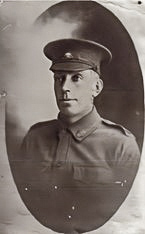
Many references in the newspapers and gazettes show that the band achieved great popularity for many years. From the Launceston Examiner, 13th July 1913:
‘…As we all know, there is no life in outdoor amusements without music, so if Stanley were without a band, the whole of Circular Head would feel it’s absence…”
It is easy to understand how big a part these bands played in the lives of town people. And in a small town such as Stanley was in 1911, Stanley Byfield King would have been very aware of the band from an early age, especially as his family were involved. By the time he enlisted, Stan appears to have become an experienced musician, going from the Stanley band to the Toowoomba band and finally to the 31st Battalion band and his additional role of soldier and stretcher bearer.
Enlistment and Service
In Toowoomba, Queensland, Mr Albert Compton was the Bandmaster of the Toowoomba Brass Band from 1914-1919. Albert (Sergeant A. Compton), along with Stan and sixteen other band members enlisted in the AIF and went to fight in World War One.
Assigned to the 31st Battalion, they trained at Enoggera Military Base. This is where Stanley was based when he signed the document nominating his widowed aunt to receive his financial allocation and when he embarked.
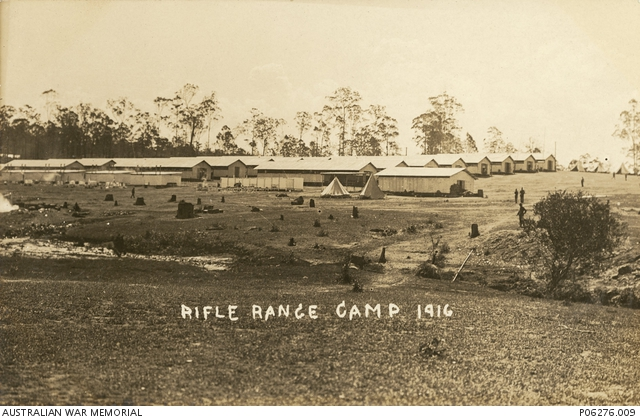
On 1st October 1915 Colonel Lee, military Commandant at the Enoggera Camp, received musical instruments “on behalf of the 31st Battalion” from the generous donations from the kind people of Queensland, and from the Queensland Patriotic Fund who “collected and earmarked for bands of the Expeditionary Forces”. Shortly before their departure from Australia in November 1915, a photo was taken of the Band of the 31st Battalion with their instruments.

“By 1916, the importance of battalion bands was firmly established with orders from various division headquarters requesting that every battalion or brigade should have a “band of some kind”. These ranged from brass and pipe bands through to the efforts by the Fourth Division to establish mouth-organ bands. The nature of warfare and the dual roles of bandsmen meant that this was not always an easy task. Casualties among bandsmen continued.“ Source AWM, Theresa Cronk
Stretcher bearer and musician.
Battalion bands were an important part of the Australian Imperial Force during the First World War, despite their unofficial status. They entertained fellow soldiers, maintained morale with their keen sense of humour, and adopted various roles when their battalions were mobilised. At a later stage the bandsmen were withdrawn from Stretcher Bearing duties as they were getting wiped out, it was decided the band was important for morale.
Stan left Australian shores on the 9th and disembarked from the HMAT “Wandilla” Suez, 7th December 1915. On the 12th January he was admitted to the No 8 Field Ambulance, Sepateum with a sprained ankle, discharged and re-joined his unit 23 January 1916.
February 1916, Suez
Private A. R. P. Jackson sent his mother the following verses from Suez:
There's a flag proudly floats o'er the ocean,
'Tis the flag of the Southern Cross so free
It fills our hearts with emotion
We've followed it across the mighty sea;
We'll plant it on battlefields of Europe,
And on trenches it will be flying first,
By the blood of our boys we will uphold it,
Here's luck to the old Thirty First.
Here's luck to the old Thirty First,
Here's luck to the bold Thirty First:
For the flag of our country will float higher,
When held by the proud Thirty First.
Then let us toast the King, God bless him,
We'll soon have fresh lands for him to rule,
No longer the German oppressor,
Our loyal sons of Austral land will fool.
There's a war-worn old Kaiser and empire,
And upon them with all our fury burst,
We will think of our little Belgium comrades.
And thrust for the old Thirty First.
Yes, thrust for the old Thirty First,
Yes, thrust for the bold Thirty First
With rifle and bayonet always ready,
Yes, thrust for the old Thirty First.
For our colonel's a man that we're proud of,
And we've got a good second in command,
The Adjutant keeps us all working.
And everyone appreciates our band:
In drill we stand above all others,
All the Germans and Turks can do their worst,
But there's nothing will daunt our brave Australians,
Three cheers for the old Thirty First.
Three cheers for the old Thirty First
Three cheers for the bold Thirty First:
There's nothing on earth that will stop us,
Three cheers to the old Thirty First.
The 31st Battalion was formed with two companies from Queensland and two companies from Victoria. Victorian enlistees trained at the camp at Flemington Depot and then at Broadmeadows. NSW enlistees initially trained at the Liverpool NSW camp. All were joined at Broadmeadows in Victoria before departing. Before sailing from Melbourne on 9 November aboard the troopship Wandilla, the 991 soldiers of the 31st had been on parade in Melbourne in front of a good crowd. In the Weekly Times (Sat 6 Nov 1915), the Minister for Defence, H.F. Pearce said:
I do not think I have ever seen a finer body of men.
Egypt
The Wandilla docked at Port Suez exactly four weeks after leaving Melbourne. Stan’s initial assignments were in Serapeum until near the end of February on to Tel el Kebir, moved for the 60 km trip in “dirty horse trucks”. At the end of March, they were moved to Ferry Post and Duntroon Camp for training and guarding the Suez Canal, before moving to Moascar at the end of May.
Stan spent the months passed in training and sightseeing, but by the time the 31st Battalion was transferred to France, the men were all heartily sick of Egypt. Private Les Smith’s (934) letter home (below) sums it up.
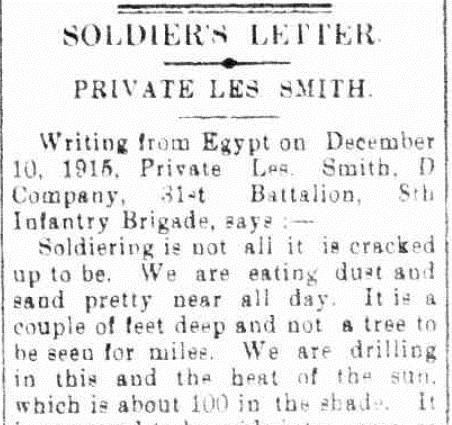
The Western Front – Fromelles
On 15 June, the 31st Battalion began to make their way to the Western Front, first by train from Moascar to Alexandria and then aboard the troopship Hororata , sailing to Marseilles. (Note, C company went on the Manitou) After disembarking on 23 June, they took trains to Steenbeque and marched to Morbecque, 35 km from Fleurbaix, arriving on 26 June. The battalion strength was 1019 soldiers.
Training continued, with how to handle poisonous gas included in their regime. They began their move towards Fleurbaix on 8 July and by 11 July they were into the trenches for the first time, in relief of the 15th Battalion. They were relieved by the 4th NZ on the 16th.
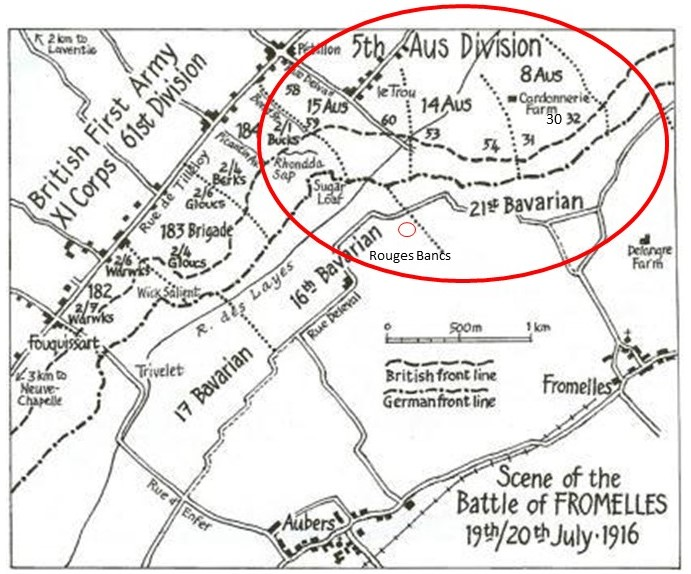
The original attack was planned for the 17th, but bad weather caused it to be postponed:
Just prior to launching the attack, the enemy bombardment was hellish, and it seemed as if they knew accurately the time set.
On the 19th they were back into the trenches and in position at 4:00 PM. The assault began at 5:58 PM and they went forward in four waves, A and C Company in the first two waves and B and D Company in the 3rd and 4th waves. The pre battle bombardment did have a big impact and by 6:30 PM the Aussies were in control of the German’s 1st line system (Trench B in the diagram below), which was described as “practically a ditch with from 1 to 2 feet of mud and slush at the bottom”. Source AWM4 23/49/12, 32nd Battalion War Diaries, July 1916, page 11.

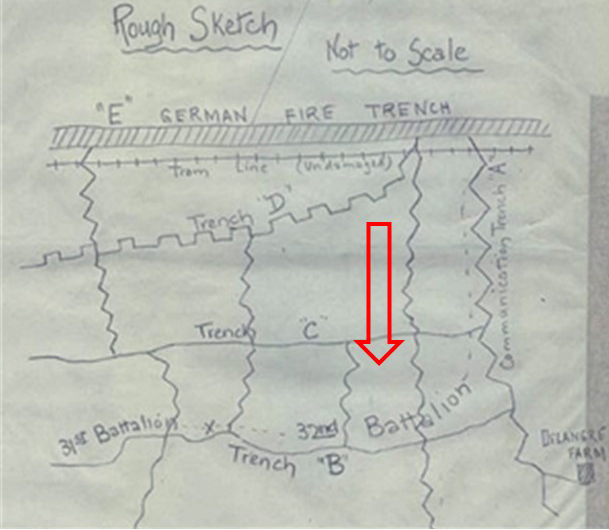
Unfortunately, with the success of their attack, ‘friendly’ artillery fire caused a large number of casualties. By 8:30 PM the Australians’ left flank had come under heavy bombardment with high explosives and shrapnel. Return bombardment support was provided and the 32nd was told that “the trenches were to be held at all costs”. Source AWM4 23/49/12, 32nd Battalion War Diaries, July 1916, page 12
Fighting continued through the night. The Australians made a further charge at the main German line beyond Trench B, but they were low on grenades, there was machine gun fire from behind from the emplacement at Delangre Farm and they were so far advanced that they were getting shelled by both sides. At 4:00 AM the Germans began an attack from the Australian’s left flank, bombing and advancing into Trench A (map). Given the Australian advances that had been made earlier, portions of the rear Trench E had been left almost empty, which then enabled the Germans to be in a position to surround the soldiers.
At 5:30 AM the Germans attacked from both flanks in force and with bombing parties. Having only a few grenades left, the only resistance the 31st could offer was with rifles:
“The enemy swarmed in and the retirement across No Mans’ Land resembled shambles, the enemy artillery and machine guns doing deadly damage.”
The 31st were out of the trenches by the end of the day on the 20th. From the 1019 soldiers who left Egypt, 72 soldiers were killed, 581 died of wounds and 85 were missing. The ultimate total was that 161 soldiers were either killed or died from wounds and of this total 82 were missing/unidentified. To date (2024), 23 of those missing have been later identified and are buried in the Pheasant Wood Cemetery.
Stan, the Tassie was missing.
The bravery of the soldiers of the 31st was well recognised by their own Battalion commanders.
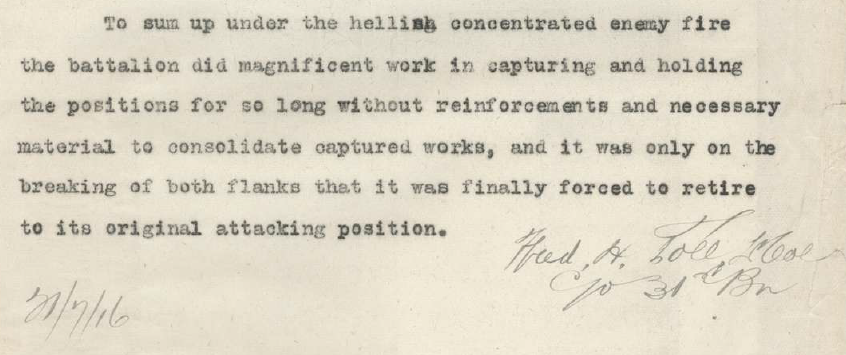
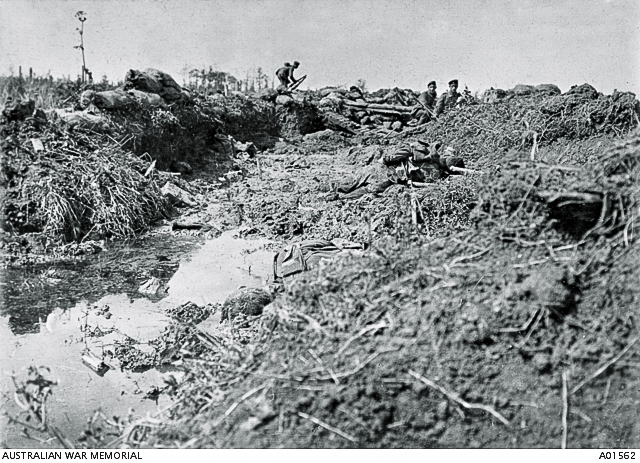
Fromelles Court of Enquiry - one year later.
A Court of Enquiry pronounced Stanley Byfield King’s fate as “Killed in Action, 20 July 1916”. His remains were never found.
A Note on Stanleys file, simply reads:
Buried in the vicinity of Fleurbaix, Sh.36 N.W.
Statement, Red Cross File No 1520214, 79 Corporal Wilfred LYNN, 31st Bn (patient, Kitchener's Hospital, Brighton, England), 3 April 1917:
'Informant states that on July 20th at Fleurbaix Pte King was killed by a shell on his way up to the Front line of trenches, he was killed instantly. The time was 3.30. p.m. and the ground was lost. Informant was not an eyewitness but saw him a few minutes after his death.'
Second statement, 6 Sergeant John.A. IRVING, 31st Bn, 5 July 1917:
'I saw Casualty in a dying condition on the 21st July at Fleurbaix between the support trench and the front line. He was smothered in blood. He was not able to speak to me. He was not quite dead at the time and was being carried by the S.B. There was no possible chance of his recovery. I heard next day that he was dead. I did not see the body.'
There were a number of letters in Stan’s Red Cross file from friends and family. Mr. George Fischer from Bundaberg, Queensland, who had a daughter Stanley had been writing to, wrote asking for information about Stanley, as his daughter had not received a letter for some time. Sergeant Albert Compton, the bandmaster, wrote a number of letters and so did his best to get a firsthand account of what happened. Fellow Band members Private Wilfred Lynn from Gin Gin, and Private William Allan Langford from Brisbane also wrote. (Both survived the war)
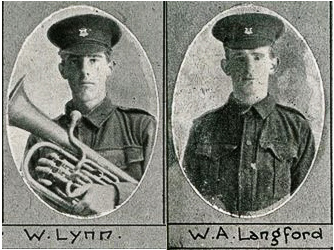
Wilfred LYNN and William LANGFORD.
In his letter Private Langford wrote:
“…It is indeed with a feeling of regret that I am unable to give you very definite about my comrade. I saw him half an hour before the charge in which we took part, and I am sorry to say I have not seen him since. He and I were mates carrying the stretcher, and as his mate I had his confidence in many things one of which was a feeling or presentiment that he would be killed in action…”
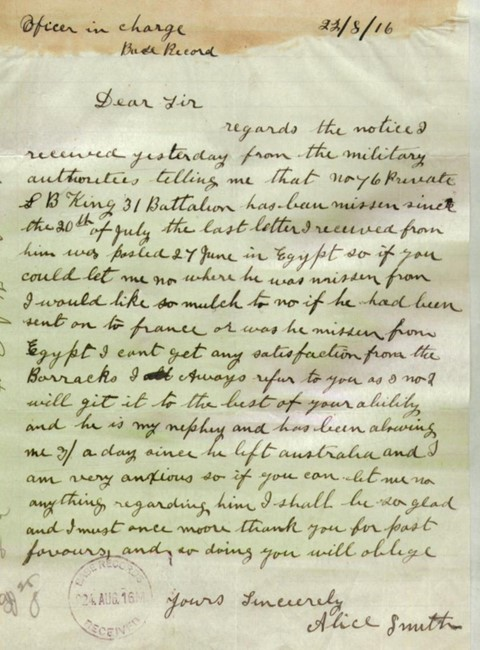
Stan’s Legacy
Stan’s Uncle remembered him fondly:
KING.—In sad and loving memory of my deal nephew, Private Stanley
Byfield King, killed in action in France on July 20, 1916.
He gave his life for his Country.
For honor, faith, and right;
With us his memory ever lives,
He fought a noble fight.
No loved ones stood around him
To bid a fond farewell,
No word of comfort could we give
To him we loved so well.
A faithful boy so true and kind,
No friend on earth like him we’ll find,
Two years have passed, and none can tell
The loss of one we loved so well.
—Inserted by his loving uncle, Roney Smith, Hobart
Reflection from family member Perry King:
“I suppose I will never know but I do wonder why my forebear did not marry Stanley's mother and on what terms they parted.”
“To know so much about a family member that we knew nothing about is something we very much appreciate. It is sad that Stanley's story ended the way it did but thanks to you he will always be remembered.”
Stan is commemorated at:
- VC Corner Cemetery and Memorial, Fromelles, France
- Australian War Memorial Roll of Honour
- Hobart Roll of Honour
- V.C. Corner Australian Cemetery Memorial
- Hobart Memorial Tree Plaque
Links to Official Records
The Fromelles Association would love to hear from you

Contacts
(Contact: carla@fromelles.info or geoffrey@fromelles.info).
(Contact: army.uwc@defence.gov.au or phone 1800 019 090).
Donations
If you are able, please contribute to the upkeep of this resource.
(Contact: bill@fromelles.info ).
